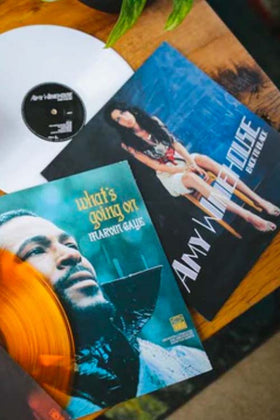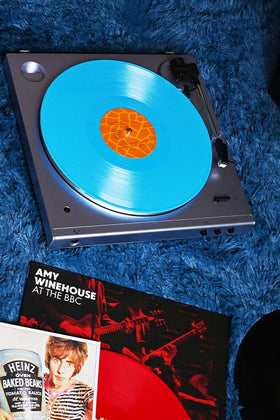How are vinyl records made?
How Are Vinyl Records Made?
Vinyl records allow record collectors and audiophiles alike to experience their favorite albums in a tactile, analog, uniquely satisfying way. And unlike streaming music, there is a lot that goes into the process of creating a vinyl record.
The process is part of the experience. Everyone who enjoys listening to vinyl should understand how the music they love got embedded into a piece of plastic. Your favorite Led Zeppelin LP didn’t just fall down from the sky—someone took time and care to create the disc that allows you to hear that music.
The process of how vinyl records are made is a long one, filled with care and craftsmanship along each step of the way until they end up at the record store. The steps have remained relatively unchanged since RCA Victor released the first black vinyl records in 1930 that were played on gramophones and phonographs invented by Thomas Edison and Emile Berliner.
Here we’re going to walk you through each step of the vinyl creation process, including recording and mastering the tracks, creating a master disk, replicating it, and more.
Recording the Music
The first step in the process of creating a vinyl record is to record the music itself. That’s the most important part, right?
This is a relatively simple process today with all the digital technology available in the music industry, but it wasn’t always so simple. Way back when, artists had to record their albums analog. This was a much more involved process than modern-day digital methods that create compact discs.
Having to record on tape took much more time—especially if you had to re-record or layer your tracks in any way. You would have to physically rewind the tape and record over what you previously did. Instead of just recording a new part and editing it in, you had to start from scratch each time.
This made recording an album much more labor-intensive than it is today. Now, people can record their parts into a computer and a sound engineer can take those tracks and edit the sound waves and recorded sounds together in a digital audio workstation.
Mastering the Tracks
Sound recording is pretty straightforward, but mastering is a unique and in-depth process. Mastering engineers will spend hours with the nearly-finished track, polishing and perfecting it until it gets to a place they’re happy with.
Mastering involves adjusting the levels of the music, applying equalization and limiting effects, and manipulating the audio in order to prepare it to be pressed on disc records. This is an intense and delicate process that we don’t have the space to cover the details on in this post.
The audio software company Ableton has a great guide on mastering for vinyl if you’re interested in learning more about it. It’s similar to mastering music for any other medium, but there are specific effects to use and steps to take when preparing a track for vinyl pressing.
Creating a Master Disk
Once the audio files are mastered and ready to go, the next step is to create a master disk that can be used to create all the other copies of the album.
Rather than polyvinyl chloride, this master disk is usually made out of lacquer. What is basically a huge turntable will spin the lacquer disc around in order to cut the audio information onto the record grooves. It’s where the phrase “let’s cut a record” came from.
The cutting stylus on the machine will imprint grooves into the disc that will eventually be used to create the grooves you will eventually find on the vinyl you purchase.
Preparing the Master for Replication
Once the master disk has been created, the next step is to prepare it for replication through a final mastering process known as electroforming or electroplating. This process helps to create templates from which all copies of the record can be produced.
There are a few steps in this process. First, technicians spray the lacquer disk with a metal coating, either silver or nickel, to produce a metal master for the disc. This material is then separated from the original shellac or lacquer into what’s called a “mother.” The mother is then used to create additional discs called stampers, which will actually be used to create the final product.
If it is a large batch of vinyl LPs, they make an additional “father” disc to create additional mothers from. There will likely be more than one stamper in a production run of a record.
These metal masters actually have ridges instead of spiral grooves that contain the information that will be pressed into the vinyl later. They will make a metal master for both sides of the disc, as well.
Pressing Copies of the Record
After they have these metal master discs created, they will attach the stamper to some kind of hydraulic press. The vinyl will run through the press as the stamper embeds the grooves into the record that can later be played back.
The vinyl doesn’t start out as a disc, though. Instead, it will look more like pellets or hockey pucks before it is pressed into what’s called a “biscuit.” They can then run the biscuit through the press, heating and softening the plastic so that the stamper can work its magic.
Once the stamping and overall manufacturing process is complete, the vinyl still needs a little polishing. They will soften up around the edges of the record, smooth everything out, and cool it off in a water bath.
After creation, vinyl also has to cool down significantly and go through a curing process before shipping. If it doesn’t have the proper time to do this, it can end up warped or damaged by the time you purchase it.
Quality Assurance
There are two primary elements in the quality control process for how to create vinyl records. The first is the test pressing, and the second is a thorough inspection.
Test pressings
Whenever a label is pressing a new record, they will run an extremely small batch first to make sure the stampers are imprinting the right information. This also gives both artists and executives a chance to hear what the final product will sound like before they ship it out.
If they aren’t happy with the test, they have an opportunity to re-record parts of the album and go again. This is a vital part of the quality assurance process.
If they decide they are happy with the record, then they will be sent off to be mass-produced. It is at this stage that regular inspections are vital to making sure the customer gets a great record.
Inspections
Even if the test pressing went great, it’s important to make sure that the final product comes out as it was intended to. That’s why companies also implement a thorough inspection process once the record goes to the final pressing.
As they continue to create more copies of the record, the manufacturer will randomly pull samples from the lot so they can check them out. You can typically expect that around two out of every 10 records will end up with some kind of defect.
Sometimes this is an issue with the grooves that prevents it from playing correctly. Other times, the vinyl will end up warped or distorted in some way, often due to issues of temperature.
This is a vital step in the process of how to create a vinyl record, as it ensures that the final product meets the standards it needs to. If a record doesn’t pass inspection, they can actually re-use the vinyl. They will break it back down into plastic and repress it.
Typically, records you purchase are made up of part new vinyl and part recycled vinyl. Some even say the recycled vinyl adds to the sound quality.
Packing and Shipping
Once the records have been pressed and passed inspection, the last step is to get them ready for sale. This involved placing them in their anti-static sleeves and cardboard album covers, packing them up, and shipping them to the retailers that will sell them.
In some cases, artists or labels will also sell vinyl directly from their own website. In these cases, they are shipped right to the customer.
Shop Vinyl Records at Sound of Vinyl
Learning how vinyl records are made from start to finish can really help you appreciate what all goes into creating the music medium we all love to listen to on our record players. If you’re looking to grow your vinyl collection, consider shopping with us here at Sound of Vinyl.
We have an extensive collection of vinyl records including brand new releases, vintage vinyl, as well as exclusive and limited-edition releases.
If you don’t have a specific record in mind, consider signing up for our curated text offers. We’ll have you fill out a short survey about your music taste, and from there we send you daily recommendations for albums we think you love.
Once you check it out, if you like it, you can just respond to the text—we’ll ship the album right to your door. And if it doesn’t sound up your alley, you can just decline. We’ll send you another option the next day.
Check out our collection. We think you’ll be able to find something you really love.
Sources-
http://americanhistorynow.org/2014/01/27/the-history-of-vinyl/
https://www.cnet.com/news/making-vinyl-records-the-old-fashioned-way/
http://americanhistorynow.org/2014/01/27/the-history-of-vinyl/




